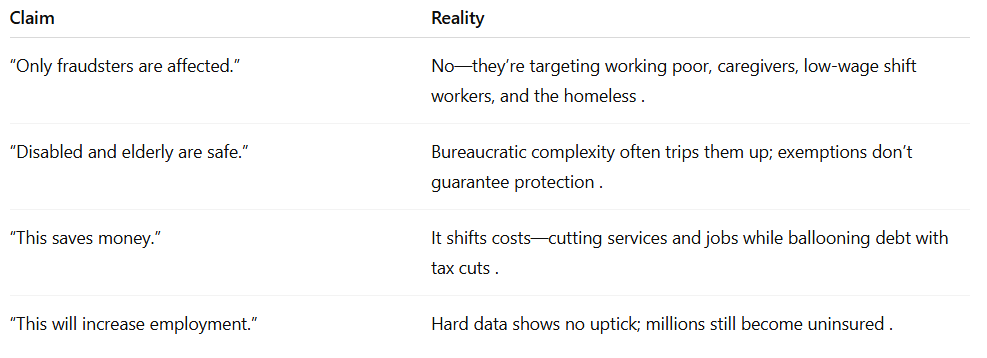The Silent Costs of a “Big, Beautiful Bill”
What the July 4th headlines left out—and why it matters for everyone
On July 4, President Trump signed the so‑called “Big, Beautiful Bill” into law—a sweeping package portrayed as a fix for Medicaid fraud and waste by imposing “work requirements” and stricter eligibility rules. Headlines boiled it down to one snappy soundbite: “Only the able-bodied freeloaders will be affected.” But that’s a gross oversimplification. What’s the full story?
1. Crushing Provider Budgets & Founder Closures
Medicaid isn’t just insurance—it’s lifeblood for hospitals, clinics, nursing homes, and home‑care programs, especially in rural and low-income urban areas:
A California doctor warns this bill could cut $1 trillion from Medicaid by 2034—shuttering rural and safety-net hospitals that couldn’t absorb the losses theatlantic.com.
Community Health Centers (CHCs), serving 31 million patients, could lose $32 billion if 5.6 million Medicaid enrollees are disenrolled commonwealthfund.org.
In rural states like North Carolina, reduced Medicaid funding could force hospitals to eliminate services like obstetrics, chemotherapy, and behavioral health—or close entirely ruralhealth.us.
This isn’t hypothetical. When Arkansas imposed work requirements in 2018, 18,000 people lost coverage, straining local providers and delivering zero employment gains kff.org. Exemptions existed on paper—but red tape and confusion nullified them, even harming the disabled healthlaw.org.
2. Hidden Toll on Caregivers & Home‑Care Aides
Many Medicaid recipients are caregivers supporting elderly or disabled family members from home. Yet, requiring caregivers themselves to log 80 hours/month of work or volunteer activity risks losing their own medical coverage justiceinaging.org. When caregivers lose coverage, patients often end up in institutions—driving up public costs and increasing emotional hardship.
3. No Real Savings—Just Shifting Costs
Politicians argue this is about slashing waste and reducing spending. Yet:
The Congressional Budget Office estimates $1 trillion in Medicaid cuts, primarily via work rules and bureaucracy theatlantic.com.
In contrast, the bill simultaneously adds trillions more to the national debt, mostly as tax breaks for corporations and the wealthy—so it's not true fiscal discipline lmtonline.com.
Who benefits? A top analysis found the richest households could gain $12,000/year, while the poorest lose $1,600 in lost Medicaid and SNAP benefits lmtonline.com.
4. Employment Paradox & Structural Disruption
Boosting employment is the story line—but jobs are already at record highs. And yet, many people are browsing LinkedIn. That’s no contradiction; it’s structural reality:
Unemployment may be low, but many jobs require different skills, aren’t available locally, or hiring is slow due to political instability, tariffs, stock market jitters, and AI anxiety.
Research shows no increase in employment from Arkansas's Medicaid work rule—and millions lost coverage urban.org.
Burdensome monthly reporting—logging 80 hours—is a bureaucratic trap. Gig workers, those with fluctuating hours, or short‑term illnesses, risk losing coverage despite wanting to work cbsnews.com.
What Aren’t They Telling You?
The Bottom Line
This “Big, Beautiful Bill” isn't just about stopping waste—it’s a structural overhaul of Medicaid, shifting trillions of dollars toward tax breaks while dismantling health coverage for working families, caregivers, rural communities, and vulnerable populations. Real-world evidence—from Arkansas to CHCs—shows the result won’t be job growth, but hospital closures, loss of services, and people left uninsured.
It’s time we challenge the polished narrative—and ask the tough questions before this becomes "business as usual."

